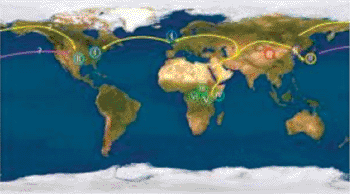Virus Validates Trail of Ancient Human Migration
By LabMedica International staff writers
Posted on 04 Nov 2013
A research project encompassing the full genetic code of a common herpes simplex virus type 1 (HSV-1) has provided a fascinating corroboration of the “out-of-Africa” pattern of human migration, which had earlier been documented by anthropologists and analyses of the human genome.Posted on 04 Nov 2013
HSV-1 typically causes nothing more severe than cold sores around the mouth, according to Dr. Curtis Brandt, a professor of medical microbiology and ophthalmology at the University of Wisconsin (UW)-Madison (USA). Dr. Brandt is senior author of the study, published online October 2013 in the journal PLOS ONE.

Image: World map featuring the geographic location of the six HSV-1 clades with respect to human migration: the phylogenetic data supports the “out of Africa model” of human migration with HSV-1 traveling and diversifying with its human host. Each clade is depicted by a roman numeral inside a circle. Land migration is depicted by yellow lines and air/sea migration is shown by the pink line. (Photo courtesy of Aaron W. Kolb, Cécile Ané, Curtis R. Brandt. Using HSV-1 Genome Phylogenetics to Track Past Human Migrations. PLoS ONE, 2013; 8 (10): e76267 DOI: 10.1371/journal.pone.0076267).
When Dr. Brandt and coauthors Drs. Aaron Kolb and Cécile Ané compared 31 strains of HSV-1 collected in North America, Europe, Africa and Asia, “the result was fairly stunning” stated Dr. Brandt. “The viral strains sort exactly as you would predict based on sequencing of human genomes. We found that all of the African isolates cluster together, all the virus from the Far East, Korea, Japan, China clustered together, all the viruses in Europe and America, with one exception, clustered together. What we found follows exactly what the anthropologists have told us, and the molecular geneticists who have analyzed the human genome have told us, about where humans originated and how they spread across the planet,” said Dr. Brandt.
Geneticists explore how organisms are related by studying changes in the sequence of bases (letters) on their genes. From knowledge of how rapidly a specific genome changes, they can build a “family tree” that shows when specific variants had their last common ancestor. Studies of human genomes have shown that human ancestors emerged from Africa approximately 150,000 to 200,000 years ago, and then spread eastward toward Asia, and westward toward Europe.
Scientists have earlier researched herpes simplex virus type 1 by looking at one specific gene, or a small cluster of genes, however, Dr. Brandt noted that this approach can be misleading. “Scientists have come to realize that the relationships you get back from a single gene, or a small set of genes, are not very accurate.”
The study employed high-capacity genetic sequencing and advanced bioinformatics to analyze the massive amount of data from the 31 genomes. “Our results clearly support the anthropologic data, and other genetic data, that explain how humans came from Africa into the Middle East and started to spread from there.”
The technology of simultaneously comparing the entire genomes of related viruses could also be helpful in determining why specific strains of a virus are so much more lethal than others. In a tiny proportion of cases, for example, HSV-1 can cause a lethal brain infection, Dr. Brandt reported. “We’d like to understand why these few viruses are so dangerous, when the predominant course of herpes is so mild. We believe that a difference in the gene sequence is determining the outcome, and we are interested in sorting this out,” he said.
For studies of influenza virus in particular, Dr. Brandt said, “people are trying to come up with virulence markers that will enable us to predict what a particular strain of virus will do.”
The researchers broke down the HSV-1 genome into 26 pieces, made family trees for each piece, and then combined each of the trees into one network tree of the whole genome, according to Dr. Brandt. “Cécile Ané did a great job in coming up with a new way to look at these trees, and identifying the most probable grouping.” It was this grouping that paralleled existing analyses of human migration.
The new analysis could even detect some complexities of migration. Every HSV-1 sample from the United States except one correlated with the European strains, but one strain that was isolated in Texas looked Asian. “How did we get an Asian-related virus in Texas?” Dr. Kolb questioned. Either the sample had come from someone who had travelled from the Far East, or it came from a native American whose ancestors had crossed the “land bridge” across the Bering Strait approximately 15,000 years ago.
“We found support for the land bridge hypothesis because the date of divergence from its most recent Asian ancestor was about 15,000 years ago,” Dr. Brandt noted. “The dates match, so we postulate that this was an Amerindian virus.”
Herpes simplex virus type 1 was an ideal virus for the study because it is easy to collect, typically not deadly, and able to form lifelong latent infections. Because HSV-1 is spread by close contact, kissing, or saliva, it tends to run in families. “You can think of this as a kind of external genome,” Brandt says.
Furthermore, HSV-1 is much simpler than the human genome, which slashes the cost of sequencing; however, its genome is much larger than another virus that also has been used for this type of study. Genetics frequently breaks down to a numbers game; larger numbers produce stronger evidence, so a larger genome generates much more detail.
But what really excited the investigators of the study, Dr. Brandt stated, “was clear support for the out-of-Africa hypothesis. Our results clearly support the anthropological data, and other genetic data, that explain how humans came from Africa into the Middle East and started to spread from there.”
In the virus, as in human genomes, a small human population entered the Middle East from Africa. “There is a population bottleneck between Africa and the rest of the world; very few people were involved in the initial migration from Africa,” Dr. Brandt stated. “When you look at the phylogenetic tree from the virus, it's exactly the same as what the anthropologists have told us.”
Related Links:
University of Wisconsin-Madison














